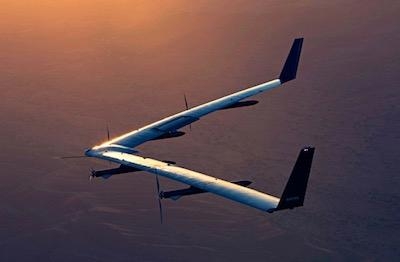Sat, Jul 01, 2017
The Aircraft Took Off, Flew And Landed Safely This Time Around
Facebook has completed the second flight of its Aquila drone it hopes to use to provide internet connectivity to remote areas of the world ... and this time the aircraft landed safely.

The 1 hour and 46 minute flight concluded with a smooth landing on the site prepared by the company at the Yuma Proving Ground in Arizona.
Writing on the Facebook blog, Martin Lois Gomez writes that the company learned some lessons from the first flight, which ended with the drone being damaged when it impacting terrain. Gomez writes that the Aquila was modified by:
- Adding “spoilers” to the wings, which help to increase drag and reduce lift during the landing approach
- Incorporating hundreds of sensors to gather new data
- Modifying the autopilot software
- Integrating new radios for the communication subsystem
- Applying a smoother finish on the plane
- Installing a horizontal propeller stopping mechanism to support a successful landing
The flight included lengthy test points at constant speed, heading, and altitude to measure the airplane’s drag. The data from these “trim shots,” as they’re called, will be used to refine aerodynamic models, which help in predicting the energy usage and thus optimize for battery and solar array size.
The aircraft's structure was also heavily instrumented with hundreds of sensors to collect data about how Aquila's shape responds to flight in real-time. These included hundreds of strain gauges and three-axis inertial measurement units (IMUs.) These tools serve to verify and refine our structural model, which predicts both the static shape of the airplane — designed to be very flexible to respond to wind gusts and maneuvers.
The aircraft landed autonomously on a 500-foot circle of level gravel about the consistency of rough sand. Aquila has no landing gear, per se, and instead lands on Kevlar pads glued to the bottom of the engine pods.
Now, the company will parse the data it collected on this flight to continue to refine and develop the aircraft for its intended use.
(Image courtesy of Facebook)
More News
With Testing Soon Complete, Launch Preparations Begin in Earnest Sierra Space's Dream Chaser has been put through the wringer at NASA's Glenn Armstrong Test Facility in Ohio, but w>[...]
Takeoff Roll The process whereby an aircraft is aligned with the runway centerline and the aircraft is moving with the intent to take off. For helicopters, this pertains to the act>[...]
“We’re proud of the hard work that went into receiving this validation, and it will be a welcome relief to our customers in the European Union. We couldn’t be mor>[...]
"Aircraft Spruce is pleased to announce the acquisition of the parts distribution operations of Wag-Aero. Wag-Aero was founded in the 1960’s by Dick and Bobbie Wagner in the >[...]
IDENT Feature The special feature in the Air Traffic Control Radar Beacon System (ATCRBS) equipment. It is used to immediately distinguish one displayed beacon target from other be>[...]
 Sierra Space Repositions Dream Chaser for First Mission
Sierra Space Repositions Dream Chaser for First Mission ANN's Daily Aero-Term (05.10.24): Takeoff Roll
ANN's Daily Aero-Term (05.10.24): Takeoff Roll Aero-News: Quote of the Day (05.10.24)
Aero-News: Quote of the Day (05.10.24) Aero-News: Quote of the Day (05.11.24)
Aero-News: Quote of the Day (05.11.24) ANN's Daily Aero-Term (05.11.24): IDENT Feature
ANN's Daily Aero-Term (05.11.24): IDENT Feature



